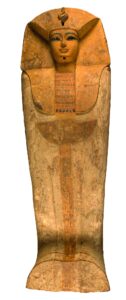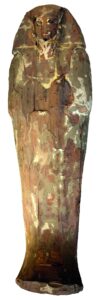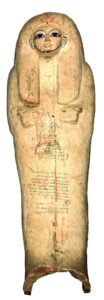Hatshepsut
Daughter of Thutmose I and Ahmose
New Kingdom, 18th Dynasty

The “Foremost of Noble Ladies,” Hatshepsut’s achievements as a powerful queen and then a ruling pharaoh have made her one of the most famous figures in ancient Egypt history. She was the daughter of Thutmose I and his principal queen Ahmose, who may have been part of the Ahmosid dynasty that founded the New Kingdom.
As a young girl, she was married to her half-brother, Thutmose II, who came to the throne after the death of their father, Thutmose I. When Thutmose II died, he left behind daughters and a son by a minor wife named Iset, Thutmose III, who was too young to rule on his own. Hatshepsut became Egypt’s regent, monarch in all but name. For several years, she ruled the country on behalf of her stepson.
In ancient Egypt, a woman could not become ruler, as the role of pharaoh was seen as exclusively masculine. However, the king could not rule without a wife by his side to assume the role of the Great Queen, symbolizing the balance of male and female and underscoring the dual nature of the created cosmos. Hatshepsut, as the daughter of a pharaoh and his Great Royal Wife, could claim the purest of royal bloodlines, and soon declared herself pharaoh, despite her gender. In her memorial temple at Deir el-Bahari, she devoted an entire wall of one portico to the mystical story of her divine birth, showing the great god Amun-Re visiting her mother, Ahmose, in the night.
This was meant to express her legitimacy, and prove that her rule over Egypt was pre-ordained.
Hatshepsut is remembered as a prolific builder who commissioned countless construction projects. Her most famous are the Red Chapel in Karnak, her work in the restoration of the Mut Precinct at Karnak, the temple of Pakhet at Beni Hasan, and the obelisks she had quarried at Aswan for the glory of Amun-Re.
She also re-established trade networks that had been disrupted during the turmoil and foreign occupation of the Second Intermediate Period. Another area of her mortuary temple was dedicated to depictions of an expedition she sponsored to the Land of Punt (which lies between modern Ethiopia and Sudan), to obtain ivory, resins, ebony, spices, and other valuable goods.
After ruling for about 22 years, she disappeared from the historical record, and Thutmose III, junior king during her tenure, became sole pharaoh. It was once thought that she might have been murdered on the orders of this king, but it is more likely that she simply died from natural causes. Her original tomb is believed to be KV 20, which lies directly over the cliffs from her memorial temple, and it is likely that she was originally buried here, along with her father.






















